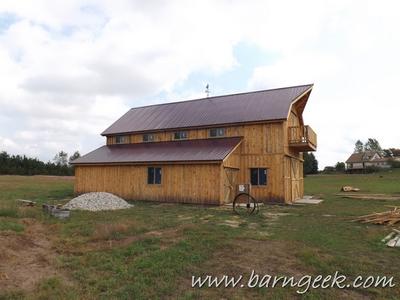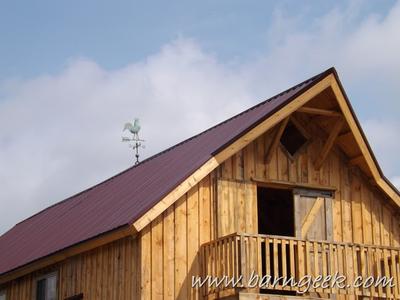

Asked by Anna from Ellensburg, WA
What is the pointy thing at the gable end of the top/ front of some barns?
It was used on old barns for lifting hay into the hay loft. Sometimes you see a pulley extending from them. Now you mostly see them for decoration. What are they called?

I grew up on a farm and my brothers and I had so much fun back in the day playing Tarzan up in our old barn, it had the outcrop and I was told it was called the crow’s beak, purpose was to project the trolley and rail system from weather , Ken Jansseune
Peak of barn
I know this as crows beak.
Tom
Barnwood Nation (Facebook)
Indiana
barn pointy thing
heard called a “bonnet”
Hay Hood
Hay Hood best describes the peak sticking out at the end of the roof line. This had two purposes 1. was to protect the rail and trolley outside the barn.
2 To give strength to the rail sticking out that far, the hay loads pulled up to the mow, via hay trolley and rail system, could weigh from 400 to 800 lbs.
timber framer artist farmer
in vermont we call this gable end a ducks beak
Loose hay “mowing away”
Mostly a hay fork( could be one of several different types)connected by block and tackle to the hay trolley that rode along the track at the peak of the barn. Once the fork was engaged with a bunch of hay, a horse on the ground would pull a rope through a series of pulleys that brought the fork up to the trolley. That would trip a mechanism that would allow the trolley to roll along the track until the person in the hay loft would pull the trip rope to release the fork load of hay at the proper location along the loft. The hay would then be mowed away with a pitch fork and pushed and pack by walking on the hay. The trolley, once the fork was tripped to release the hay, would then before to travel back ou under the “pointy roof” where the fork would be dropped back down to the wagon and the process would be repeated until the wagon was emptied. Usually a bare minimum of three people to do the work, and usually a child would lead the horse back and forth for the lift and return of the hay fork on the trolley.
Functional Widows Peak
I can see how a pulley could be used to hoist goods UP to the hayloft. Once up there did the load just get swung through the door?
Will
Hi Anna,
Great question! I have heard three different terms for them.
1. Widow’s Peak – presumably that has to do with the hooded garment that a mourning widow would wear, and how the hood would apear similar to the hay trolley peak on a barn.
2. Hay hood – because it was used to cover the outside of the hay trolley system.
3. Crows Beak – presumably because it resembles a crows beak.
If anyone else out there have heard other names for it, please share in the comments below.
-BarnGeek
In, response to Will’s question below.
Hi Will,
The pulley was usually on a track that ran the entire length of the barn called a Hay Trolley. Many times the hay was hoisted all the way up to the peak then pulled into the barn where it was released into the Hay Mow. Oh, and the hay was loose, not baled like we see it today.
That is only a very basic description of the process. The whole system was fairly complex with several pulleys inside the barn for depositing the hay in different places through the barn, each of these pulleys was located near or at the top of the queen posts and ladders were built into the barns frame system to allow the farmer to climb up to the pulleys.
The next time you get a chance to look inside an old barn, take a moment and observe where the pulleys and ladders, are. Look for the trolley system at the peak, and let your mind imagine how the whole process worked.
The most fascinating system I have seen did not use a widow’s peak at all. In fact many barns loaded hay through the large sliding door in the side of the barn.
This one had a very large wheel or wooden pulley, I’d say it was about 12 feet in diameter. It had a large round oak axle that spanned from one bent to the next directly above the slider door.
The wheel or pulley had several wooden pegs in it spaced about one foot apart.
I imagine that it was used to lift the hay by human power instead of horse power, or maybe the farmer had only small horses.
This barn was also the oldest barn I have ever been inside of dating to before the civil war. There was not one piece of machine sawn wood in that barn.
Unfortunately, I didn’t get pictures, and I don’t remember where it is.
-BarnGeek